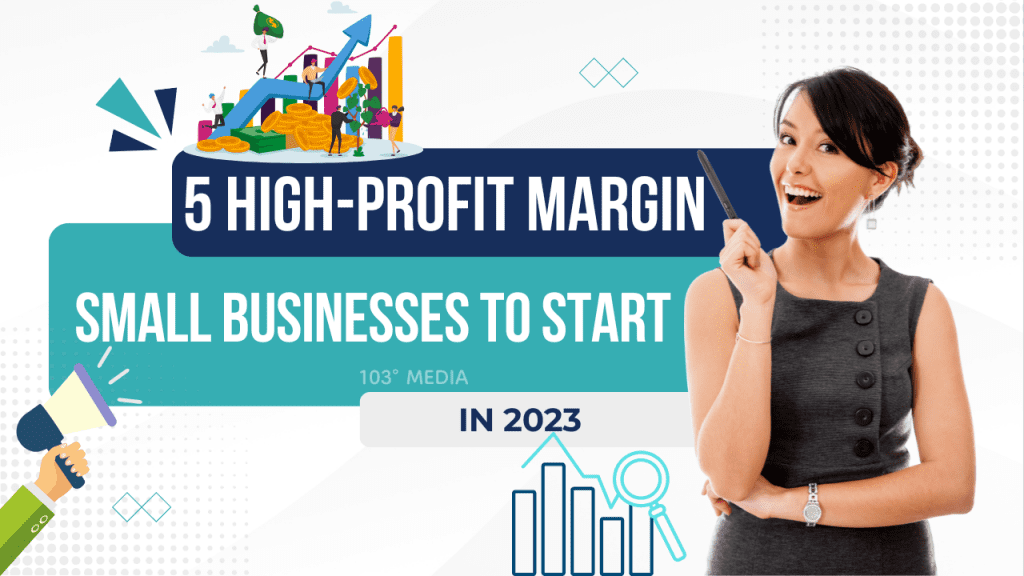You wanted to start a business with a good return on investment (ROI). But you’re confused about which small businesses with high-profit margins to choose because there’s so much information. This article is great if you want to know which small businesses make the most money.
This article goes into detail about five small businesses that make a lot of money. The best thing about these businesses is that they can be started with little money and make a lot of money in just a few months.


So, do you want to learn more? Let’s Dive Deep…
Which Sectors Have the Highest Returns on Investment?
The industries with the highest average profitability should be noted before deciding which small business is the most profitable. It’s important to remember that profit margins are averages and can vary greatly depending on the product or service being offered.
| INDUSTRY | NET PROFIT MARGIN | DESCRIPTION |
| Banks | 31.31% to 32.61% | This includes both regional banks and money centers |
| Financial services | 8.87% to 32.33% | From accounting and bookkeeping to asset management, investment banking, or brokerage services |
| Software | -10.36% to 29.04% | Includes internet software, entertainment software, and systems and application software |
| Real estate | -3.17% to 21.77% | From general real estate to real estate development, operations, services, and Real Estate Investment Trusts (REITs) |
| Health care | 2.42% to 16.64% | Healthcare information and technology, healthcare products, and support services |
| Homebuilding | 12.73% | Homebuilding and development |
| Restaurant/Dining | 12.63% | Retail restaurants and dining services |
| Insurance | 8.87% to 12.64% | General insurance, property and casualty insurance, and life insurance |
| Retail | 1.11% to 9.63% | Everything from automotive, building supplies, distributors, grocery and food, online retailers, and special retail lines |
Some of the industries in the table above have a range for the net profit margin. This means that some parts of that industry make more money than others. As a small business owner, you can use the average net profit margins of your industry to find places where you can make money.
With all the information, tools, and resources available to everyone, starting a small business has never been easier. First, look at the data and see how it fits with your experience, interests, and what the market needs. Then, start making a business plan.
Read More: 8 Principles of Launching a Startup
1. Software as a Service (SaaS)
Average profit margin: 19 to 25%
What is SaaS?
“Software as a service,” or “SaaS” for short, is a way to give people access to software programs over the Internet. Instead of dealing with the hassle of installing and updating software, you can get what you need by simply accessing it online, freeing up valuable time and resources.
Web-based, on-demand, or hosted software are all terms used to describe what SaaS applications essentially are. It doesn’t matter what you call them, SaaS apps use the hosting services of a SaaS provider. The service provider is in charge of how the user interacts with the app, including how easy it is to use, how reliable it is, and how well it works.
SaaS advantages
Many companies have started using SaaS solutions in the cloud because they are more efficient and cheaper. Some benefits are:
a. Cheap initial investment and underlying infrastructure
You only ever pay for what you use, and there are no upfront costs or sunk costs that will eventually have to be written off as an expense.
b. Can be accessed from any location
You can do your job from any location so long as you have access to a computer, tablet, smartphone, or other internet-connected device and can connect to the internet.
c. Scalability
As your company expands, your needs will change in terms of the number of users, the amount of data, and the features demanded.
d. Uptime and performance SLAs that are the best in the business
As a result, you can rest easy knowing the software will be accessible when you need it, a guarantee that is often difficult for in-house teams to make.
e. Regular & automatic updates
The providers are able to make timely enhancements due to their size and the feedback they receive from their customers. Your company’s IT staff will now be available for more pressing matters.
f. Protection on par with the strictest standards demanded by any client
In a shared service like this, the security measures taken to protect the most vulnerable users ultimately benefit everyone.
Software as a Service: Where It’s Going
The evolution of cloud computing and SaaS has been rapid. SaaS products, including IaaS and PaaS, have experienced meteoric growth thanks to rising demand and the prevalence of SaaS Integration Platforms (SIPs) (PaaS). IT tasks that are not essential to running a business will continue to be outsourced to specialists. By outsourcing hardware and software IT concerns to service providers, businesses are free to focus on their core competencies and develop comprehensive, integrated solutions.
Companies’ increasing use of “aaS” services will foster deeper, more committed partnerships between them and their providers, which in turn will spur creativity as providers better meet their clients’ evolving demands.
In the future, high-performance computing will be useful for many business tasks, such as analyzing large amounts of customer data and keeping an eye on application logs. Predicting which customers will churn or which cross-selling practices work best for your business are two examples of critical challenges that SaaS may one day be able to help address.
It’s not hard to see why so many companies are turning to cloud-based providers, what with the ever-increasing demand for high-volume data, software performance, and backup. Check out what Salesforce has to offer companies of all sizes if you’re thinking about making the switch to a SaaS platform.
Read More: How to Write a Business Plan?
2. E-Commerce Store
Average profit margin: 10 to 18%
The business of online shopping is growing like crazy. Some stores that closed for a short time may never open again.
Online shopping used to be convenient and a treat, but now it’s a must. I work with online stores that can’t keep enough products in stock. E-commerce has been growing for a while, and the numbers below don’t include recent events that have made more people buy things online.
Many people want to know how to start an online store. If your goal is to make money quickly, that’s all you’ll do. Instead, your goal should be to build a business that can grow and make money for a long time. If you want to build something that has real value on the market, you have to think about the long term.
The following considerations are likely to spring to mind when asked how to initiate an online retail enterprise:
- Great website design
- Top-notch customer support
- A high-quality product image
- Unique selling proposition
Indeed, you are correct. This line of reasoning is completely reasonable. Success requires a dedicated focus on satisfying customers. If you want people to buy from you online, you need a site that is both aesthetically pleasing and reliable.
Advantages of eCommerce for Start-ups
- Global reach
With eCommerce, small and medium-sized businesses (SMEs) can sell their items to anyone in the world, even if they don’t have a physical store. eCommerce can help small and medium-sized businesses (SMEs) reach a wider range of countries by letting them connect across borders.
Consumers look up products online to find out more about them and compare the different options. So, search engine optimization can be a good way for a small or medium-sized business to make itself more visible to potential customers all over the world.
- Low trade barriers
Since there are fewer barriers to entry for new eCommerce businesses, around 20% of all online sales each year come from new eCommerce businesses. eCommerce has also helped break down barriers by giving developing countries, young entrepreneurs, people who work in rural areas, and women a way to take part in international trade.
With the improvement of internet technology, a website can be set up for a small fraction of the cost of a store. This lets small and medium-sized businesses (SMBs) and start-ups get online with only a small investment in eCommerce solutions.
- Cost savings
For an eCommerce store to work, the entire buying process, including check-out, billing, and payment processing, must be automated. This means that there is no need for extra staff to handle these parts of the business.
Inventory management software that automates and keeps track of an online store’s stock and inventory will save SMEs time and money.
Online eCommerce is also a low-cost way to keep in touch with current customers and spread the word about the business to a large number of potential new customers. Small and medium-sized businesses can save money on traditional advertising and marketing costs.
- Money flow
Automating as many administrative tasks as possible is the key to improving your cash flow, and eCommerce is by definition an automated shopping experience that can help generate a flow of short-term revenue. Because your online store is always open, customers can shop whenever and wherever they want.
With drop-shipping, you can save money that you would have spent on stock. Money that was once spent on a physical store can now be put toward other parts of the business.
- You can get information quickly
Small and medium-sized businesses (SMEs) can easily measure the success of sales campaigns, marketing campaigns, and other customer engagement efforts by looking at the information generated by online sales.
Analysis of data helps small and medium-sized businesses (SMEs) figure out how their customers spend their money so they can better meet their needs and give them the right products every time they visit their online store.
In the same way, both current and potential customers have access to a lot of information. In your online store, you can make it easy for customers to find detailed information about every product you sell. This can be a great way to attract and keep customers.
How to Do Well in eCommerce?
For SMEs to be successful online, they need to make sure that the whole eCommerce chain works smoothly. This is more than just setting up an online business. Small and medium-sized businesses must-have items in stock and ready to ship as soon as a customer places an order.
International payment methods need to be set up, and freight and shipping companies need to be notified so that both domestic and international deliveries can be made on time. SMEs also need to decide how they will handle services after the sale.
In the end, an SME’s success in eCommerce depends on how quickly and efficiently it can ship high-quality products to customers all over the world.
3. Food Truck
Average profit margin: 7% to 10%
According to reports, after five years of steady growth, the food truck industry will grow to $6.6 billion by 2028. For a fraction of the price of a traditional restaurant, you can launch a mobile eatery complete with its own unique menu, the ability to travel to wherever your customers are, and high-profit margins.
Keep in mind that the food truck market is already pretty saturated in larger, hipper cities like San Francisco, Boston, and Washington, DC (and there are stricter regulations to get started there), so this might be a more successful business in a smaller, more traditional metropolis in the heartland.
Ordinances, commercial licenses, and health and safety regulations for food trucks are often unique. Additionally, food businesses need insurance; check with your county health division to learn the specifics.
Read More: Startup 101: A Startup Guide For New Entrepreneurs
4. Real Estate Rentals
Average profit margin: 7% to 12%
What is a business that rents out homes?
A rental property business is a way for an investor to buy and manage one or more properties that bring in money. One or more of these properties can be rented out to tenants for a monthly fee per unit. Investors can have a good rental plan even if they don’t manage the properties themselves. Property management companies can do things like collect rent and take care of repairs that are usually done by landlords.
Is the house I rent out a business?
Depending on who you ask, renting a house could be seen as a business. This question might seem controversial, and there are at least two possible answers to think about. From a financial point of view, renting out a home could lead to passive income. When investors report their rental properties, they do not have to pay self-employment taxes. So, many people would say that having a rental property is not a “business,” especially when it comes to filing taxes.
But from a career point of view, many people live off of passive income from their rental property businesses. From this point of view, renting a house can be seen as a business. It is possible to run a business out of managing a group of rental properties.
Still, people who only have one rental property might not need to start a business in order to get passive income. When the rental portfolio starts to grow is when it becomes more important to turn renting into a business.
How to start a business that rents out homes?
Learning how to start a business renting out homes isn’t all that different from learning how to do just about anything else. Before starting a business, investors need to know a few key things. This will help them get their business off on the right foot. Here are some of the most important things to think about when writing a business plan for a rental property and starting a real estate business:
- Join your local REI club and start making connections.
- Choose a market and a niche for your rental property
- Find the right money and make sure you have it.
- Do the research you need to and hire a manager.
- Set up systems to make things work better.
- Take care of the properties and grow the business at a rate that is sustainable.
How to write a business plan for a rental property?
Starting a business that rents out homes are one thing, but learning how to write a business plan for a rental property business is something completely different. Even though they sound the same, the second one is what makes the first one even stronger. At the very least, you should know how to start a rental property business before you do. Because of this, investors will need to learn about the most important steps first:
- Write a mission statement and come up with a vision.
- Set business and side income goals
- Set up your team in a way that will help it succeed.
- Get a big-picture view of the company as a whole.
- Make marketing systems and funnels that are geared toward a certain group.
How Should Rent Be Calculated?
Comparing the asking rent with those of similar properties in the neighborhood is a good starting point. First, check out the going rate for comparable units, and then look at the average rental prices. Take note of comparable homes that share the same number of bedrooms, bathrooms, and other features. This allows you to determine the best price range.
There is also the option of using your current monthly loan repayment as a starting point, and then increasing it to account for unexpected costs like repairs and upkeep. Again, it’s important to keep an eye on the typical market when estimating maintenance costs. Extra storage space is useful if your rental home is located in a busy area like a university town. On the other hand, if you have a tenant lined up in advance, you may be able to reduce your reserve fund for maintenance.
The final cost must be consistent with neighboring homes’ prices. There may, however, be some leeway in selecting the precise location of your home. Remember that charging too little leads to lost income, while charging too much leads to vacancies.
5. Tax Preparation Services
Average profit margin: 18 to 20%
Let’s face it: taxes are a necessary evil that often keeps founders from focusing on the most important parts of their business and adds unnecessary stress. The taxes for your business are also more complicated than your own taxes. Founders often miss deadlines, deductions, and credits, which can cost them money or even have real consequences in some cases.
Things don’t have to be like that!
What do you need to be able to work from home?
Set up a space at home where you can work on your client’s tax returns without being interrupted.
Some of the things you’ll need to get your home-based tax business going are:
- A computer that works well and has good anti-virus and anti-malware software
- The rest of the office staff (e.g., printer, copier, scanner, and fax machine)
- Internet service
- Professional tax preparation software
- IRS forms
- Business cards
- Office supplies (paper, stapler, pens, binders, highlighters, notebooks, etc.)
- A place to keep tax records and a way to file them
There is a huge market to collect taxes from businesses and consumers who are legally obligated to do so. Financial advisors and tax preparers work together to help individuals and businesses with their tax returns. You can expect a profit margin of 20% or more when providing tax preparation services, though this will vary greatly depending on the fees you charge.
Recurring Inquiries (FAQs)
For a startup to turn a profit, how long does it usually take?
When a company first opens its doors, it typically loses money. This is because they are just getting started in the market and have yet to establish a solid foundation for sales and customer loyalty. A small business usually takes between 18 and 24 months to turn a profit. 6
When it comes to starting a business, which one do you recommend?
Start a small business in an area that interests you and in which you have some background knowledge. In the beginning, it may feel like you’re working nonstop on your business. If possible, choose a field in which you have prior experience and interest to make the time go by more quickly.




